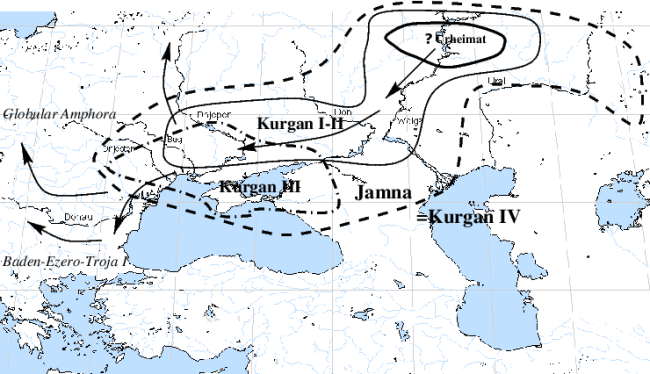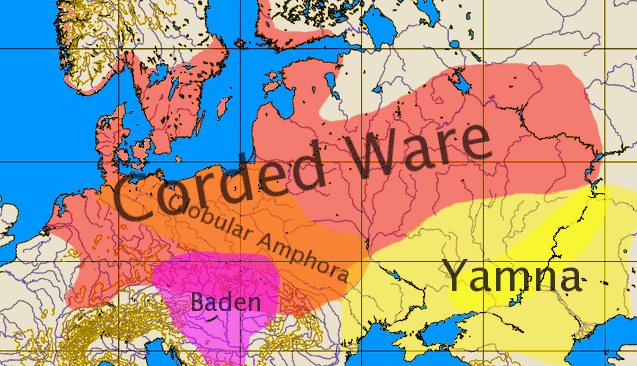Texts and images of this section are licensed under the GNU Free Documentation License (FDL). Part of the content has been obtained (and modified) from the English Wikipedia, the Online Free Encyclopaedia. We do NOT support the actual content of these Wikipedia articles, though, as anyone can change them at any time. Only the information reproduced here is supported, although it is possibly less accurate than the present Wikipedia article.
1. The search of the Urheimat or Homeland of those who first spoke PIE has developed along with the linguistic research, being the Archaeology the science which helps the most in looking for this hypothetical common prehistoric land.
2. The peoples who spoke IE III, already separated from IE II dialects (such as Anatolian) were probably located in the steppe north of the Caucasus, in the surroundings of the Volga river. This location combine the expansion of the Northern and Southern dialects, and agree also with the Kurgan hypothesis.
 Map of the hypothetical Homeland or Urheimat of the PIE speakers, from 4500 BC. The Yamnaya or Jamna (Pit Grave) culture lasted from ca. 3600 till 2200. In this time the first wagons appeared. People were buried with their legs flexed, a position which remained typical for the Indo-Europeans for a long time. The burials were covered with a mound, a kurgan. During this period, from 3600 till 3000 the IE II split up into IE III and Anatolian. From the 3000 on, IE III Dialects began to differentiate and spread by 2500 westward (Northern Dialects) and to the southwest (Greek and possibly Armenian) and southeast (Indo-Iranian). By 2000 the Dialects' breach is complete. [© gfdl]
Map of the hypothetical Homeland or Urheimat of the PIE speakers, from 4500 BC. The Yamnaya or Jamna (Pit Grave) culture lasted from ca. 3600 till 2200. In this time the first wagons appeared. People were buried with their legs flexed, a position which remained typical for the Indo-Europeans for a long time. The burials were covered with a mound, a kurgan. During this period, from 3600 till 3000 the IE II split up into IE III and Anatolian. From the 3000 on, IE III Dialects began to differentiate and spread by 2500 westward (Northern Dialects) and to the southwest (Greek and possibly Armenian) and southeast (Indo-Iranian). By 2000 the Dialects' breach is complete. [© gfdl]
3. The European or Northern Dialects have developed in the European Subcontinent, but, because of the migrations, they have undergone different changes. Their original common location is usually traced back to some place to the East of the Rhine, to the North of the Alps and the Carpathian Mountains, to the South of Scandinavia and to the East of the Russian plain, not beyond Moscow. This linguistic theory is usually mixed with archaeological findings:
 2000BC: The Corded Ware (in slight red) complex of cultures traditionally represents for many scholars the arrival of the first speakers of Northern Dialects in central Europe, coming from the Yamna culture (in yellow). The complex dates from about 3000-2000. The Globular Amphorae culture (in orange) may be slightly earlier, but the relation between these two cultures is unclear. Denmark and southern Scandinavia are supposed to have been the Germanic homeland, while the present-day West Germany would have been the Celtic (and possibly Italic) homeland; the east zone, then, corresponds to the Balto-Slavic homeland (their proto-languages certainly developed closely, if they weren't the same). [© gfdl]
2000BC: The Corded Ware (in slight red) complex of cultures traditionally represents for many scholars the arrival of the first speakers of Northern Dialects in central Europe, coming from the Yamna culture (in yellow). The complex dates from about 3000-2000. The Globular Amphorae culture (in orange) may be slightly earlier, but the relation between these two cultures is unclear. Denmark and southern Scandinavia are supposed to have been the Germanic homeland, while the present-day West Germany would have been the Celtic (and possibly Italic) homeland; the east zone, then, corresponds to the Balto-Slavic homeland (their proto-languages certainly developed closely, if they weren't the same). [© gfdl]
4. These are the archaeological findings and the corresponding linguistic theories, put side by side for comparison.
|
LINGUISTICS (Three-Stage Theories) |
|
|
ca. 4500-4000: Sredny Stog, Dnieper-Donets and Sarama cultures, domestication of the horse. |
The early Proto-Indo-European or PIE language. |
|
ca. 4000-3500: The Yamna culture, the kurgan builders, emerges in the steppe, and the Maykop culture in northern Caucasus. |
IE II. Two known dialects, Proto-Anatolian and Proto-IE III begin to differentiate. |
|
ca. 3500-3000: The Yamna culture is at its peak, with stone idols, two-wheeled proto-chariots, animal husbandry, permanent settlements and hillforts, subsisting on agriculture and fishing, along rivers. Contact of the Yamna culture with late Neolithic Europe cultures results in kurganized Globular Amphora and Baden cultures. The Maykop culture shows the earliest evidence of the beginning Bronze Age, and bronze weapons and artefacts are introduced to Yamna territory. |
IE III and Anatolian have split up into two distinct languages. Anatolian is isolated south of the Caucasus, and have no more contacts with the IE III innovations. |
|
3000-2500. The Yamna culture extends over the entire Pontic steppe. The Corded Ware culture extends from the Rhine to the Volga, corresponding to the latest phase of Indo-European unity. Different cultures disintegrate, still in loose contact, enabling the spread of technology. |
IE III disintegrates into various dialects corresponding to different cultures. They remain still in contact, enabling the spread of phonetic and morphological innovations, as well as early loan words. |
|
2500-2000. The Bronze Age reaches Central Europe with the Beaker culture of Northern Indo-Europeans. Indo-Iranians settle north of the Caspian in the Sintashta-Petrovka culture. Slavics and Baltics develop in north-eastern Europe. |
The breakup of the southern IE dialects is complete. Proto-Greek is spoken in the Balkans and Proto-Indo-Iranian north of the Caspian. The Northern Dialects develop in Northern Europe, still in loose contact. |
|
2000-1500: The chariot is invented, leading to the split and rapid spread of the Iranians and Indo-Aryans from the Andronovo culture and the Bactria-Margiana Archaeological Complex over much of Central Asia, Northern India, Iran and Eastern Anatolia. The pre-Celtics Unetice culture has an active metal industry. |
Indo-Iranian splits up in two main dialects, Indo-Aryan and Iranian. In Europe, Germanic, Celtic (and maybe Italic or Proto-Latin), Baltic and Slavic differentiate from each other. Proto-Greek dialects are already written. |
|
1500-1000: The Nordic Bronze Age sees the rise of the Germanic Urnfield cultures and the Celtic Hallstatt cultures in Central Europe, introducing the Iron Age. Italics move to the Italian Peninsula. Rigveda is composed. Mycenaean civilization in Greek Dark Ages. The Hittite Kingdoms flourish and decline. |
Germanic, Celtic and Italic are already different languages, developing in turn different dialects. |
|
1000-500BC: Northern Europe enters the Pre-Roman Iron Age. Early IE Kingdoms and Empires in the East. In the west, Classical Antiquity begins with the Greeks. Foundation of Rome. |
Celtic dialects spread over Central and Western Europe. Osco-Umbrian and Latin-Faliscan are attested in the Italian Peninsula. Greek and Old Italic alphabets appear. The Anatolian languages become extinct. |